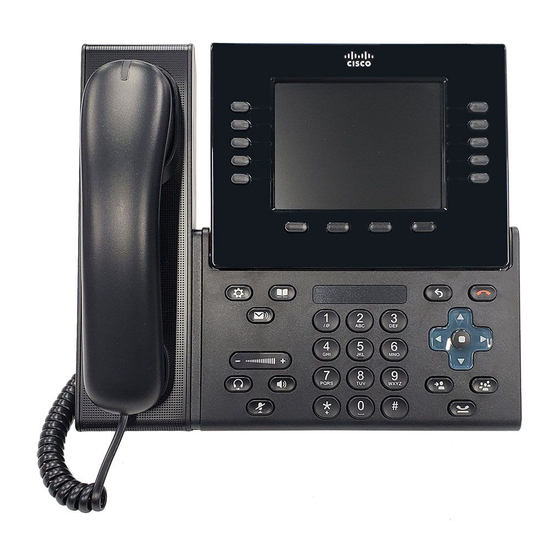What Networking Protocols are Used?
What Networking Protocols are Used?
Cisco Unified IP Phones support several industry-standard and Cisco networking protocols required for
voice communication.
Cisco Unified IP Phone 8961, 9951, and 9971 support.
Table 1-4
Supported Networking Protocols on the Cisco Unified IP Phone
Networking Protocol
Bluetooth
Bootstrap Protocol
(BootP)
Cisco Audio Session
Tunnel (CAST)
Cisco Discovery Protocol
(CDP)
Cisco Peer-to-Peer
Distribution Protocol
(CPPDP)
Dynamic Host
Configuration Protocol
(DHCP)
Cisco Unified IP Phone 8961, 9951, and 9971 Administration Guide for Cisco Unified Communications Manager 8.5 (SIP)
1-10
Table 1-4
Purpose
Bluetooth is a wireless personal area
network (WPAN) protocol that specifies
how devices communicate over short
distances.
BootP enables a network device such as
the Cisco Unified IP Phone to discover
certain startup information, such as its IP
address.
The CAST protocol allows the Cisco
Unified IP Phones and associated
applications to discover and communicate
with the remote IP phones without
requiring changes to the traditional
signaling components such as Cisco
Unified CM and gateways.
CDP is a device-discovery protocol that
runs on all Cisco-manufactured
equipment.
Using CDP, a device can advertise its
existence to other devices and receive
information about other devices in the
network.
CPPDP is a Cisco proprietary protocol
used to form a peer to peer hierarchy of
devices. This hierarchy is used to
distribute firmware files from peer devices
to their neighboring devices.
DHCP dynamically allocates and assigns
an IP address to network devices.
DHCP enables you to connect an IP phone
into the network and have the phone
become operational without your needing
to manually assign an IP address or to
configure additional network parameters.
Chapter 1
provides an overview of the networking protocols that the
Usage Notes
Cisco Unified IP Phone 9951 and 9971 support
Bluetooth 2.1
—
The Cisco Unified IP Phone uses CAST as an
interface between CUVA and Unified CM using the
Cisco IP Phone as a SIP proxy.
The Cisco Unified IP Phone uses CDP to
communicate information such as auxiliary VLAN ID,
per port power management details, and Quality of
Service (QoS) configuration information with the
Cisco Catalyst switch.
CPPDP is used by the Peer Firmware Sharing
feature.
DHCP is enabled by default. If disabled, you must
manually configure the IP address, subnet mask,
gateway, and a TFTP server on each phone locally.
Cisco recommends that you use DHCP custom
option 150. With this method, you configure the
TFTP server IP address as the option value. For
additional supported DHCP configurations, go to
the
Dynamic Host Configuration Protocol
and the
Cisco TFTP
Communications Manager System Guide.
If you cannot use option 150, you may try
Note
using DHCP option 66.
An Overview of the Cisco Unified IP Phone
chapter
chapter in the Cisco Unified
OL-20861-01

